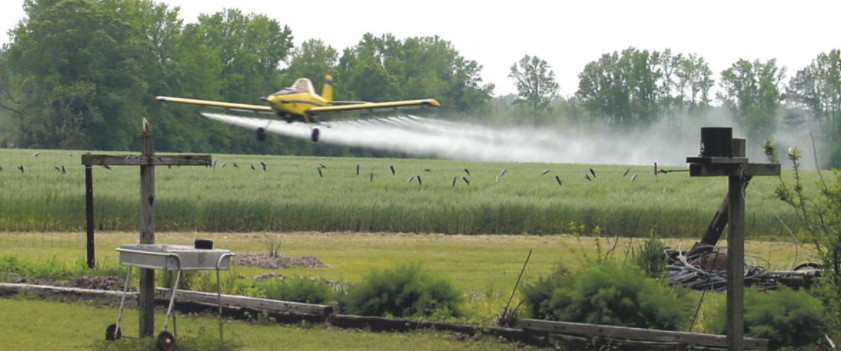Paraquat®
Paraquat, a notoriously toxic herbicide was originally developed and manufactured by Imperial Chemical Industries (now Syngenta) in the late 1950s. The chemical is a ‘restricted use pesticide’ under federal US law, meaning it cannot be sold, used, or possessed by any person without proper licensing and permit. Paraquat was first marketed in the early 1960s under the brand name Gramoxone® and exclusively marketed by Chevron USA until 1986, when Syngenta took over the marketing of the chemical as well.
The herbicide is commonly used by scientists in research laboratories to artificially induce Parkinson’s disease in lab animals. The chemical is designed to create oxidative stress on the cells of plants and animals, causing ‘redox cycling’, of which a single paraquat molecule can trigger the production of destructive superoxide radical molecules.
Paraquat was banned in most European countries nearly two decades ago. Even China, a nation not known for environmental regulation said that it would ‘phase-out paraquat to safeguard peoples’ lives’ as of 2012. Though they remain the world hub for Paraquat production. Though questions have been posed and the issue became newsworthy as early as 2013 in the US, Paraquat remains one of the most ubiquitously used herbicides, where more than seven million pounds of the chemical was prayed across more than 15 million acres of farmland in 2016.
EPA Review
Over the past decade, numerous new damning studies have continued to provide more conclusive data on the correlation between Paraquat and Parkinson’s. In 2011, the Farming and Movement Evaluation (FAME) study, led by Dr. Caroline Tanner, Director of the Parkinson’s Disease Research, Education and Clinical Centers at the San Francisco Veterans Affairs Medical Center, found that persons exposed to Paraquat were 2 ½ times more likely to develop Parkinson’s disease. A 2012 Study found that exposure to Paraquat by individuals with a particular genetic variant had an 1100% increased risk of the development of Parkinson’s, suggesting that a warning for this particular group of people was imperative. Finally, in October 2019, the EPA took an important new step in its regulatory review of Paraquat when it made the Draft Risk Assessment available for public comment.
MDL
MDL #3004, District of Southern Illinois, Judge Nancy J. Rosenstengel
Current Status Of Litigation
On June 7, 2021, the US Judicial Panel of Multidistrict Litigation (JPML) ordered the consolidation of claims into MDL #3004, with cases transferred to the U.S. District Court of Southern Illinois, where they will be centralized under the supervision of Judge Nancy J. Rosenstengel. A coordinated proceeding in California state court overseen by Hon. Edward J Weil, JCCP #5031, was resolved in June 2021. On April 18, 2024 Judge Rosentengel dismissed four bellwether lawsuits after rejecting plaintiffs general causation expert after the Daubert hearing.
Important Links
- https://www.nytimes.com/2016/12/20/business/paraquat-weed-killer-pesticide.html?auth=linked-google
- https://pubmed.ncbi.nlm.nih.gov/12826488/
- https://www.huffpost.com/entry/golf-parkinsons_b_2589611
- https://www.nytimes.com/2016/12/20/business/fact-check-paraquat-weed-killer-parkinsons.html
- https://www.ncbi.nlm.nih.gov/pmc/articles/PMC3114824/
- https://pubmed.ncbi.nlm.nih.gov/23045187/
- https://www.nytimes.com/2016/12/20/business/paraquat-weed-killer-pesticide.html?auth=linked-google
- https://www.epa.gov/pesticides/epa-makes-paraquat-draft-risk-assessments-available-public-comment
- https://www.farmprogress.com/herbicide/11-facts-know-about-paraquat-herbicide
MDL Links
- https://www.ilsd.uscourts.gov/mdl/mdl3004.aspx
- https://usrtk.org/wp-content/uploads/2021/06/2021-06-18-Notice-of-Settlement-of-Coordinated-Cases.pdf
Case Management Orders
- Paraquat Transfer Order
- Paraquat CMO 1
- Paraquat CMO 2
- Paraquat CMO 3
- Paraquat CMO 4
- Paraquat CMO 5
- Paraquat CMO 6
- Paraquat CMO 7 (PFS & PAQ)
- Paraquat CMO 7 (Exhibit 1 Assessment Questionnaire PAQ)
- Paraquat CMO 7 (Exhibit 2 Defendant PFS – Proposed)
- Paraquat CMO 7 (Exhibit 3 PAQ)
- Paraquat CMO 7 (Exhibit 4 PFS)
- Paraquat CMO 7 (Adoptions of Special Master Recommendations)
- Paraquat CMO 8
- Paraquat CMO 9 (Common Benefit)
- Paraquat CMO 9 (Exhibit A)
- Paraquat CMO 10 (PAQ Implementation)
- Paraquat CMO 11 (Removal of Some Defendants)
- Paraquat CMO 12 (Bellwether Protocols)
- Paraquat CMO 12 (Adoption of Special Master Protocols)
- Paraquat CMO 13 (Rule 502(d))
- Paraquat CMO 14
- Paraquat CMO 15
- Paraquat CMO 16 (Reset of Expert Deadlines)
- Paraquat CMO 17 (Procedure for Daubert)
- Paraquat CMO 18 (Deceased Plaintiff Submissions)
- Paraquat CMO 19 (Daubert Hearing and Motions)
- Paraquat CMO 20 (Additional Limited Discovery)
- Paraquat CMO 21 (Limiting 3rd Party Discovery)
- Paraquat CMO 22 (Additional on Limiting 3rd Party Discovery)


